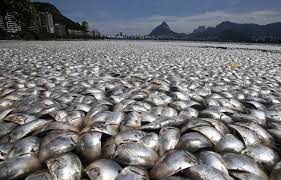Fish farming (aquaculture) has become a crucial industry to address the rising global demand for seafood. While aquaculture offers solutions to overfishing and food security concerns, it also presents its own environmental challenges; pollution being one of them. This essay seeks to explore this aspect of aquaculture more closely by looking at its effect on water quality, marine ecosystems and human health as a result of fish farming activities.
Water Quality Pollution
Nutrient Enrichment
Fish farming involves the use of fish feed, which contains nutrients such as nitrogen and phosphorus. Excessive feeding and inefficient feeding practices result in the release of excess nutrients into surrounding aquatic environments. These nutrients can trigger eutrophication, causing algal blooms that deplete oxygen levels in the water, leading to hypoxic or dead zones.
Chemical Inputs
Fish farms often employ various chemicals, including antibiotics, pesticides, and antifoulants, to control diseases and parasites, maintain water quality, and prevent the attachment of organisms to infrastructure. Improper use and overreliance on these chemicals can result in their release into the surrounding ecosystem, potentially harming non-target organisms and disrupting natural ecological processes.
Organic Waste Accumulation
Fish excretions and uneaten feed contribute to the accumulation of organic waste in fish farm systems. If not adequately managed, as noted by a fish expert, Ian, “…this waste can settle on the seafloor, leading to sediment contamination and altered benthic ecosystems. Moreover, the decomposition of organic waste consumes oxygen, further exacerbating the risk of hypoxia.”
Impact on Marine Ecosystems
Disease and Parasite Transfer
High fish densities in aquaculture facilities can facilitate the transmission of diseases and parasites among farmed fish. Escaped or released farmed fish carrying pathogens and parasites pose a threat to wild fish populations, potentially leading to disease outbreaks and genetic intermixing that can negatively impact biodiversity and ecosystem balance.
Genetic Interactions
Escaped farmed fish can interbreed with wild populations, resulting in genetic interactions. This can lead to reduced genetic diversity in wild populations, making them more vulnerable to environmental changes and decreasing their overall resilience.
Habitat Alteration and Loss
Just like Clara Dell, an aquatic life writer, noted, “…establishment of fish farms often requires the modification of coastal habitats, including the destruction of mangroves, wetlands, and seagrass beds.” These habitats serve as critical nurseries and feeding grounds for numerous species, and their loss can disrupt marine food webs and negatively impact biodiversity.
Human Health Concerns
Antibiotic Resistance
Fish farms’ use of antibiotics to prevent and treat diseases contributes to the spread of antibiotic-resistant bacteria, creating a public health threat, as infections resistant to medical treatments reduce their effectiveness leading to increased morbidity and mortality in humans.
Chemical Contamination
The release of chemicals used in fish farming, such as antibiotics, pesticides, and antifoulants, can contaminate surrounding water bodies. Through bioaccumulation and biomagnification, these chemicals can enter the human food chain, potentially posing health risks to consumers of farmed fish and seafood.
Nutritional Concerns
Farmed fish diets tend to differ significantly from that of wild counterparts. Farmed fish are usually fed formulated diets which may contain lower levels of beneficial omega-3 fatty acids and higher concentrations of contaminants than wild counterparts. This disparity can have implications for human nutrition and health outcomes.
Mitigation Strategies
Best Management Practices (BMPs)
Implementing and enforcing BMPs in fish farming operations can significantly reduce pollution. These practices may include optimizing feed formulations to minimize nutrient discharge, implementing feeding strategies that match the nutritional needs of the fish, and reducing the use of chemicals through integrated pest management approaches.
Site Selection and Monitoring
Choosing appropriate locations for fish farms is crucial to minimize their impact on water quality. Factors such as water circulation, depth, and proximity to sensitive habitats should be considered. Regular monitoring of water quality parameters, such as nutrient levels and dissolved oxygen, can help detect and address pollution issues promptly.
Waste Management
Efficient waste management systems are essential to prevent organic waste accumulation and minimize its impact on water quality. Strategies such as sedimentation ponds, mechanical filtration, and the use of waste capture devices can help remove solid waste, while biological treatment systems can aid in the breakdown of organic matter.
Integrated Multi-Trophic Aquaculture (IMTA)
IMTA is an innovative approach that combines the cultivation of multiple species, such as fish, shellfish, and seaweeds, in a single system. This practice promotes nutrient recycling, as the waste from one species becomes a resource for another. By integrating various trophic levels, IMTA can reduce the environmental impact of fish farming and enhance overall ecosystem resilience.
Alternative Feed Sources
Developing and utilizing alternative feed sources can help reduce the reliance on wild fish stocks for fish feed production. Sustainable alternatives such as plant-based feeds, algae-based feeds, and insect-based feeds can decrease the pressure on marine resources and minimize the environmental footprint of fish farming.
Regulatory Framework and Certification
Government regulations and industry certifications play a vital role in promoting environmentally responsible fish farming practices. Stringent environmental standards, regular inspections, and certification programs can incentivize fish farmers to adopt pollution mitigation measures and ensure compliance with sustainable practices.
Research and Technological Innovations
Continued research and technological advancements are essential for addressing pollution concerns in fish farming. This includes developing improved feed formulations to minimize nutrient discharge, exploring alternative energy sources for fish farm operations, and advancing water treatment technologies to remove contaminants effectively.
Conclusion
While fish farming has the potential to alleviate pressure on wild fish stocks and meet global seafood demand, it is crucial to address the pollution impact associated with this industry. Actions such as better feed management, reduced chemical inputs, waste disposal practices and developing sustainable aquaculture systems can all help minimize pollution from fish farming. By adopting environmentally responsible practices in its operations, aquaculture industries can ensure long-term fish production while mitigating any negative impacts to water quality, marine ecosystems or human health.










